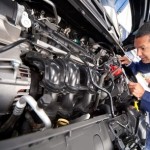 Cars are increasingly intelligent, year after year. There are so many mechanical monitors and computers used to ensure automobile functionality and smooth operation, mechanics who retired 20 years ago would need a lot of new tools, and probably a repair tutorial. With these advancements, home auto maintenance is increasingly daunting. But they also make our lives much easier.
Cars are increasingly intelligent, year after year. There are so many mechanical monitors and computers used to ensure automobile functionality and smooth operation, mechanics who retired 20 years ago would need a lot of new tools, and probably a repair tutorial. With these advancements, home auto maintenance is increasingly daunting. But they also make our lives much easier.
As soon as your engine oil starts losing viscosity and becomes saturated with dirt and metal particles, it poses serious risk to the longevity of your engine. Dirty, old oil directly results in overheating, gasket separation and a whole host of other issues. This is why regular oil changing is imperative. But changing oil every 3,000 miles isn’t the rule of thumb for all proper maintenance.
Most engines nowadays, especially larger ones that don’t have to work as hard, can function perfectly with less frequent oil changes. Very subjective to the automobile itself, there are now monitors available indicating when specific cars are in need of new oil based on climate, typical conditions and how gently the car is driven.
Oil breaks down much quicker and gets much dirtier under certain conditions than others. A 4-cylinder Jeep Wrangler driven in August in the Greater Phoenix area will lose oil viscosity much quicker than a 6-cylinder Lexus ES350 driven in February in Boston. Hotter, dustier conditions call for more frequent oil changes because of the lack of relief to hot engine conditions and the dirt makes for more engine sludge.
There is no consistent oil-change interval prescription to all car engines across all conditions. This is why monitoring systems are in place to indicate when your specific vehicle is need of new oil. The monitoring systems take all the guess work out of not only when your oil is spent, but also getting the most mileage and dollar from your previous oil change.
This complex monitoring systems work in one of two ways; direct oil measurement and algorithm measurement. The algorithm measurement will trip the maintenance light based on certain time and mileage since the last detected oil change. It’s pretty basic in comparison to the direct monitoring device and doesn’t monitor the oil directly, and therefore is less accurate. The direct measurement, however, is much more accurate and complex.
Drawing samples from your oil reservoir, direct monitoring measures a range of properties before it trips the maintenance light. For starters, the more contaminants and water is in oil, the easier it conducts electricity. So measuring for conductivity with a quick charge is one indicator telling your monitoring system you need an oil change. There are also devices in place to measure how thick oil is based on how lucid and thin it is. Other subjective indicators measure soot and water concentration as well.
Although some of the new technology makes it more daunting for the home mechanic to adjust and maintain their cars, they are also extremely helpful. The new monitoring technologies they install in vehicles not only make it easier to gage when attention is needed, but save car owners money as well.
Auto Maintenance Not One Size Fits All
Leave a Reply




